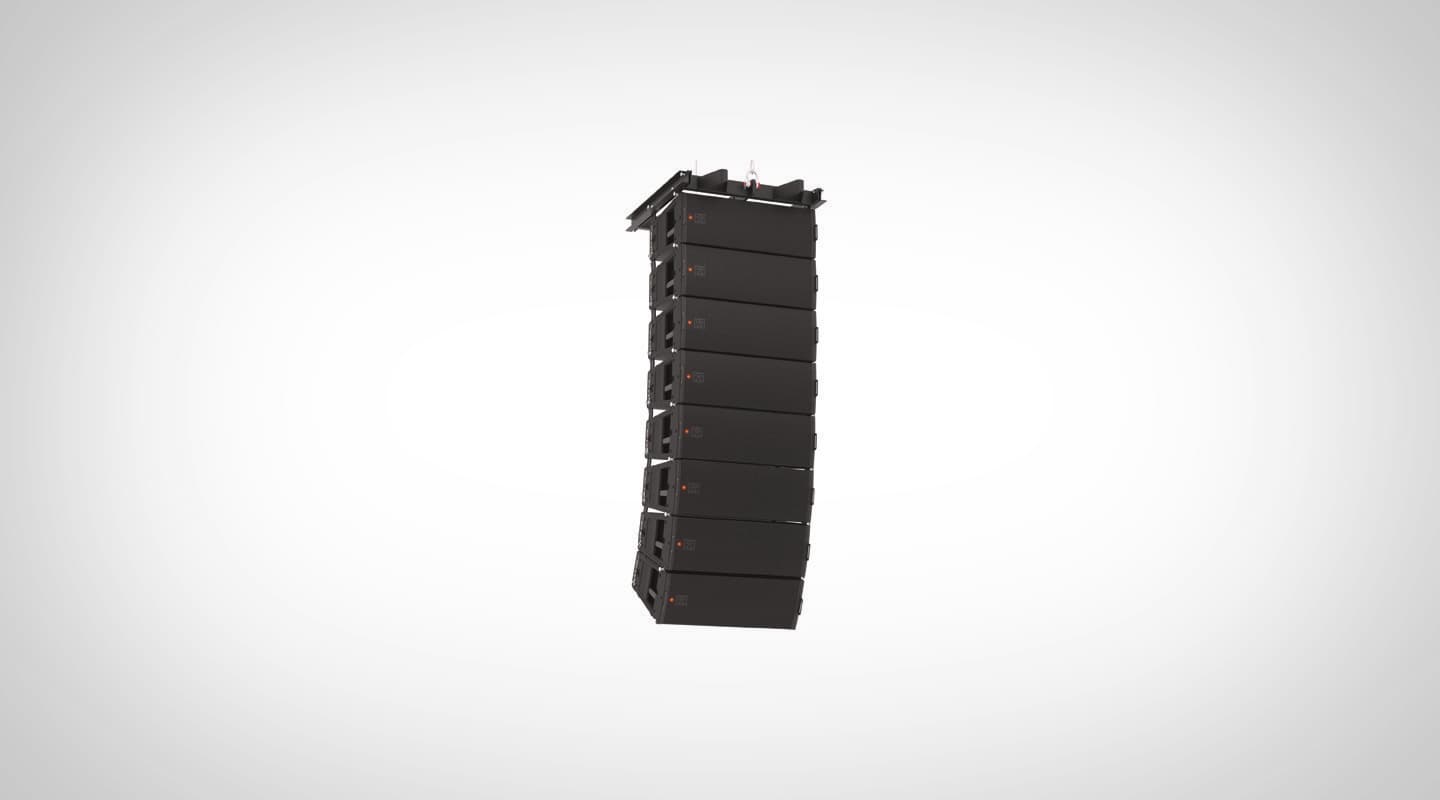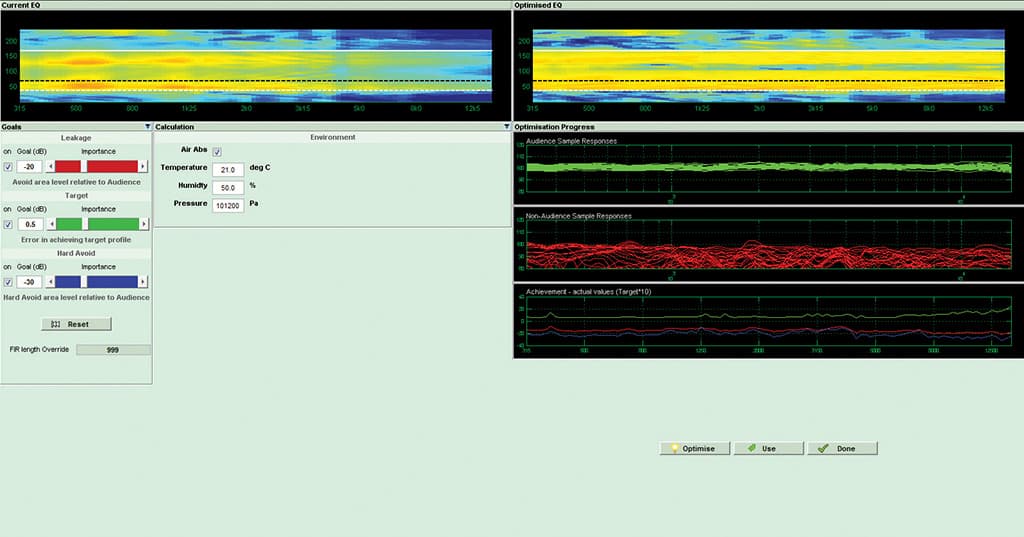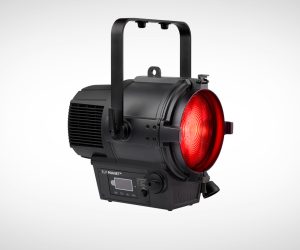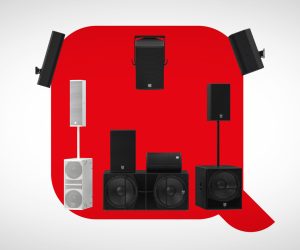
Martin Audio MLA Compact
A new medium-format PA with the sort of control system designers crave. Checkmate?
Review:/ Christopher Holder
I very occasionally play chess. Mostly against the computer, and, given my lack of chops, it’s normally on the Easy mode. Quite often I’ll win, which isn’t as satisfying as you might think. In Easy mode, it’s obvious the computer is only thinking one move ahead. If, for example, you offer up a bishop as bait, with the next move being checkmate, the computer falls for the obvious sacrifice every time. There’s no consideration for the next move.
Witnessing really experienced system designers in action is a little like watching chess grandmasters going at it. They know all the opening gambits – there’s nothing in the first 10 moves or so they’ve not seen before – and it’s not really ‘game on’ until quite deep into the match. Good system designers will get you 90% there with experience and their ears. The system’s modelling software and processing can then take over. But most software relies on you punching in some ‘what ifs’ and it’ll show you the predicted results — put another box in the array, splay the array a little more etc. Not exactly what you were hoping for? Then throw some alternative what-ifs into the mix.
But to continue the chess metaphor some more, what if half way into a match – with the remaining pieces poised on the board – you could ask the computer to show you the best, most elegant means to checkmate your opposition in 10 moves. The software would need to consider every permutation, not just a couple of ‘what ifs’. After all, every move impacts the options available on every other piece on the board. The complexity is mind boggling.
This is where Martin Audio is heading with MLA. Once it has the details of the room and your aims for the sound, it can marshal its chess pieces with an unprecedented level of sophistication.
FROM BIG CHEESE TO FINE GRAINS
When L-Acoustics revolutionised the PA world with V-DOSC it encouraged us to understand its technology by considering the array as one large line source — a giant speaker, essentially. Thanks to speaker coupling, a V-DOSC array was (and is) chucking out a single ‘iso-phasic’ wavefront… like a big wedge of cheese. It was an utter revelation, without the destructive interference of the overlapping patterns of multiple speakers, music lovers were enjoying ‘nearfield’ sound in a concert environment for the first time.
Over the years, line array sound has been tidied up even further with the advent of more sophisticated digital signal processing. The likes of the Lake DSP (now owned by lab.Gruppen) made the most of the best in digital signal processing to largely eliminate crossover distortion, and to apply EQ without phase incoherencies. By being able to address each speaker box individually, or better still, to address the highs, mids and lows within the box, the system engineer/designer has considerable control at their fingertips.
The logical end point to all this fine-tune-ability is having the luxury of individually addressing every single driver in the array, with its own DSP and amp channel. In so doing, you would have enormous scope to tweak the coverage and frequency response of the array to best fit the venue and the demands of the audience.
Essentially, this is what Martin Audio is promising with its ‘multi-cellular
loudspeaker array’.
MLA SHOE HORN
Before you start thinking MLA is a triumph of algorithms over acoustics, it’s worth noting that the MLA Compact is a primo piece of engineering. Martin has shoe-horned a seemingly impossible complement of drivers, processing and amp modules into a very tidy package. The three-way enclosure houses 2 x horn-loaded 10-inch drivers, 2 x five-inch horn-loaded mids, and 4 x 0.7-inch HF devices. This firepower is driven by five Class D amps (delivering a total of 2.1kW continuous) boasting 135dB @ 1m for one enclosure, along with 65Hz–18kHz ±3dB frequency response and 100° horizontal dispersion (6dB down). At less than 800mm across and 280mm high, it’s an impressive piece of design.
MORE INFO
CONTACT
Technical Audio Group:
(02) 9519 0900
[email protected]
www.tag.com.au
BRAINS BEHIND MLA COMPACT
Chris Holder talks to Martin Audio Research Manager, Ambrose Thompson, about the MLA multi-cellular approach.
Chris Holder: Martin Audio has gone out on its own with this multi-cellular approach. What prompted this ‘line of enquiry’?
Ambrose Thompson: If you cast your mind back to the start of the modern touring line array era, everyone assumed a line array must be uniformly driven – the same signal to every single point. For a long time it was the dominant dogma we heard preached. When Martin Audio began experimenting with line array we realised that approach simply wasn’t flexible enough – because using just the array shape to compensate for air absorption wasn’t always practical. Instead, we looked at our six-channel system controller and contemplated how to get the most out of it. So we decided to split the array into six zones. We used three channels for the HF, two channels for mids and one channel for low frequencies. We found that it gave us a much higher degree of control in compensating for environmental effects and we developed individual settings for different array shapes. That was back in 2001, and the technique we’re using now is a development of what we did then. Really, it started off with the motivation that the users were getting a pretty raw deal – they were handed a whole bunch of speakers and just told to get on with it.
CH: So it was the lack of flexibility of line array that you were responding to?
Ambrose: Sure. When we made our first line array, we put a uniform flat signal through it – like the dogma told us to – and it didn’t work properly. At the time we had no acoustic model and didn’t know what to expect. We ended up with an enormously bass heavy output. We quickly applied global EQ to balance the system and while it sounded impressive in some positions, it was frustrating that the only way we could alter the tonal balance relative to a position was by mechanically changing the shape of a very heavy array.
CH: What next?
Ambrose: We began to think about how best to optimise the array. The first step was getting its shape and splay angles right for the room it was in. We started to apply our ‘numerical optimisation’ to achieve that.
CH: ‘Numerical’ optimisation?
Ambrose: I qualify the word ‘optimisation’ with ‘numeric’ because ‘optimisation’ is a term bandied around in an inaccurate way. People talk about optimising an array, but what they’re really talking about is manual trial and error. What we’re doing is quantifying the output of the array (or the ‘quality’ of the array) on the audience (and, just as importantly, not the audience) with numbers, and these numbers are optimised.
CH: So you used maths to optimise the shape and splay of the array elements. What next?
Ambrose:: We thought, now let’s try doing a similar thing with EQ. We did an experiment in software and the results – the level of control and uniformity of sound over a designated area – were astonishing. We built some prototypes and eventually we got to the point where we released a product.
CH: The MLA?
Ambrose: Actually, the first system to benefit from this approach was the Omniline, an install product with very small elements and a fixed requirement for coverage. In this application pure shape control and numerically optimised global EQ works well. And, actually the first ever system to use numerically optimised elemental EQ was an Omniline array that [Australians] Glenn Leembruggen and David Gilfilian fitted to the Royal Institute in Adelaide. Then we released the MLA.
CH: And that’s the MLA’s secret sauce isn’t it. You’ve gone a long way to perfecting the EQ optimisation.
Ambrose: It didn’t come easily. We realised that we needed an accurate acoustic model and we needed to do a lot of work to be broadband accurate. The early models were good enough at high frequencies to do the array splay optimisation, but needed fine tuning for EQ. If you don’t know what’s really coming out of your speaker then there’s a good chance you can make it a lot worse.
CH: How did you arrive at the new IndexPlot?
Ambrose: The new plot is quite a nice side effect of our optimisation work. Let’s not forget, there are two domains we’re interested in as system designers: Space (a position in the audience) and Frequency. These were always served too much in one area – you’d have loads of frequency plots in one position or loads of positions at one frequency.
Part of the optimisation process was to look at all frequencies at the one time, together with this accurate acoustic model. The model needed to be comprehensive and, above all, needed to be really fast – in fact, we can solve the acoustic output of an array at all frequencies in a medium-sized venue in way less than a second, which is one or two orders of magnitude under what is currently available elsewhere.
CH: The plot takes a little getting used to.
Ambrose: But once you’re accustomed to it you’re seeing so much more – what the array is doing throughout the venue at all frequencies. And once you’ve got it into your head, it’s a case of ‘why would you want to look at anything else?’.
Alternatively, most software programs plot the output of a system in the air. You look at a plot, a section view, and it shows you colouring in the air above people’s heads. That’s computationally very wasteful. I mean, who cares what’s going on above people’s heads?
CH: Are you asking more of the user? Is a more accurate room model required to drive the MLA Compact?
Ambrose: There’s a minimum effort required. You need a reasonably accurate description of the room in 2D. The software was designed from the perspective of a touring user, so we’ve set very tight time limits on how long a process should take. Put it this way, it would surprise me if anyone would take more than 20 minutes to map out a room well enough for optimisation; plug in some defaults; optimise it; and get the results. That was the philosophy behind it: we can’t be faffing around with forensically accurate measurements.
Saying that, I think the system will especially reward those with very specific problems – something they really would like to avoid or enhance. I see that more as a consultant’s job. The consultant has more time to spend, and will be rewarded.


DISPLAY2.1
How do you show the coverage of a system across all frequencies on the one plot? Like this. IndexPlot is like a vertical slice through the room, with dotted and full lines showing where seating areas and walls or stage zones begin/end. Denote certain surfaces as ‘hard avoid’ zones (like balcony fronts) and Display2.1 will crunch the numbers to steer the array’s sound away.

SIDE BY SIDE
The speaker configuration is a little unusual for a compact system. The lows are horn-loaded, while the mids and highs sit side by side. According to Martin, by avoiding the usual co-entrant/crossfiring/co-ax approach the MLA Compact can achieve a far more even and predictable horizontal coverage pattern.
CELLULAR REPRODUCTION
Squeezing eight highly-efficient drivers into a compact enclosure is one thing but to achieve the party tricks Martin Audio are justifiably proud of takes some sophisticated software and a decent amount of processing grunt.
Martin’s Display2.1 software does things a little differently to your average modelling program. Don’t panic, I won’t start talking about chess again. Once you punch in a 2D model of the room geometry, you then help Display2.1 to distinguish between the stage, the ceiling, the audience and other no-go areas (like a balcony front). Display2.1 will give you the hang height and splay for the number of elements you have in the truck. All fairly normal thus far. Except in the way the software does its coverage plots. Called IndexPlot it shows a 2D slice through the venue, allowing you to see how loud the array is at all measuring positions and at all frequencies. It takes a little getting used to but once you’re accustomed, it’s a potent visualisation of the vertical domain.
From this point you can get your array in the air, whereby Martin’s VU-Net communication protocol (over Cat5) will send the onboard digital signal processors the optimised EQ settings (along with the other DSP parameters). The approach is arguably more deliberate than what most system engineers have at their disposal – i.e. tweak, tinker, measure, repeat – and takes advantage of the fact Display2.1 is addressing the system on a cellular level.
In fact, let’s not kid ourselves, that cellular level control is the game changer. You can have the most sophisticated software in the world but it’s not until you’re able to address every single driver individually does the ‘resolution’ of that tonal and SPL control increase exponentially. It’s like comparing a game of chequers to chess… after all, the biggest CPU in the world won’t make a game of chequers any more sophisticated.
EYEING OFF COMPACT
The large-format MLA has made a creditable international splash since its launch a few years ago. But without technical rider pressure from touring bands it wasn’t going to find much of a home in the crowded Australian rental market. The MLA Compact is a different kettle of fish. It’s a far more versatile beast with much broader appeal. A 12-box array will happily fill a 5000-seat venue, while a larger rig (up to 24) will take care of just about any festival gig Australia has to offer. Having heard the MLA Compact in action on a couple of occasions, there’s no doubting it’s a great-sounding, punchy system with great clarity and vocal reproduction – much like other high-quality competing medium-format systems from the likes of d&b, Adamson, EAW and others – but where Martin has stolen a march on its opposition is in control. The MLA Compact offers a superbly consistent performance across the entire audience area.
So who’s the MLA Compact for? Aspirational rental companies, willing to buy into MLA philosophy, will be rewarded with arguably the most technically advanced PA on the market today. The rental kit has everything you’ll need, including a road-ready tablet PC, rigging, dollies etc. Yes, there are companion subs as well. As for the price? Expect to pay much the same as the other ‘AAA’ rated mid-sized PA systems.
Installers will have access to the most ‘finesse-able’ system on the market. The system can be remotely controlled and with the tools that are on offer, and the level of modelling sophistication, system designers will be in
hog’s heaven.
MLA Compact couldn’t have existed not that long ago. Fortunately with highly efficient/low weight amplification, lightweight switched mode PSUs, ever more sophisticated DSP talking to today’s grunty portable PCs, a ‘multi-cellular array’ like this is possible. Undeniably it is a step forward and there is no question that in coming years we’ll see other manufacturers doing something similar under a variety of other three-letter acronyms. But for the moment, when it comes to being ‘the thinking man’s PA’, Martin Audio is the only game in town.
COMPACT CV
Dimensions: (W) 788 × (H) 280 × (D) 500mm
Weight: 49.5kg
Drivers: 2 × 10-inch, 2 × 5-inch, 4 × 0.7-inch
Power: (LF) 500W AES, 2000W Peak; (MF) 180W AES, 720W Peak; (HF) 40W AES, 160W Peak
Dispersion: 100° (-6dB)
Frequency Response: 65Hz–18kHz ±3dB
Max SPL @ 1m: 135dB Peak















RESPONSES